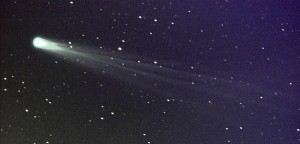Just now caught this in The Baltimore Sun, a nice review of 1973’s Comet Kohoutek, relating it to this year’s Comet ISON.
Back Story: Comet Kohoutek Was Another Flameout
Like ISON, it didn’t live up to the hype
By Frederick N. Rasmussen, The Baltimore Sun
December 5, 2013
Comet ISON is pictured in this Nov. 19, 2013, handout photo by NASA, taken using a 14-inch telescope located at the Marshall Space Flight Center at 6:10 a.m. EST with a three-minute exposure. (NASA, Reuters, November 27, 2013)
Comets ISON and Kohoutek will forever share two things. Both were hailed as “Comets of the Century,” and both failed to live up to the hype attending their impending arrival in our solar system.
Unlike Comet Hale-Bopp, which put on a grand show in 1997 before departing the inner solar system for a 3,000-year journey through deep space, comets ISON and Kohoutek were profound flops that left thousands of disappointed stargazers across the world who had high expectations for experiencing a somewhat-rare celestial occurrence.
No one knows more about the unpredictability of comets and their fickle ways than Dr. Lubus Kohoutek, the Czechoslovakian astronomer who discovered the comet that would be named for him on March 7, 1973, while studying photographic plates at the Hamburg-Bergedorf Observatory in Germany.
News surrounding the important discovery of Kohoutek — whose formal scientific designation was C/19731 — was underscored by Dr. Brian Marsden who headed the International Clearinghouse for Astronomical Discoveries in Cambridge, Mass.
“I wouldn’t be a bit surprised if Comet Kohoutek ends up being classified as the best comet of the century,” Marsden told The Evening Sun. “An object that large should achieve unusual brightness and produce an exceptional tail.”
Anticipation of its arrival in late November was fueled by initial reports that it was larger than the famed Halley’s Comet of 1910, whose tail extended some 60 million miles, and that Kohoutek had last made a pass by the sun some 10,000 years ago.
The Evening Sun built anticipation by saying Kohoutek “wasn’t just any comet. It is a comet with a capital C,” adding that it had been “60 years since a major naked-eye comet appeared.”
The incessant drumbeat by the press kept up, even reporting that the British liner Queen Elizabeth 2 had on board 1,963 comet enthusiasts who had booked a special cruise off the coast of South Carolina in which to take in the comet.
And then the bottom began to fall out by mid-December.
“The much-publicized Comet Kohoutek is proving to be a disappointment to sky-watchers, if not a fizzle,” reported The Wall Street Journal, with the newspaper reporting two weeks later that the comet was a “celestial box-office dud because it isn’t dirty enough.”
A NASA official explained to The Wall Street Journal that “Comet Kohoutek turns out to be a comet that has much less dust than expected,” adding that gas dust is the essential component in forming spectacularly beautiful tails that can be seen by the naked eye when they are near the sun.
In early January 1974, the comet was growing fainter as it traveled away from the sun at the speed of 163,000 mph, some 85 million miles away from Earth, as it went back to where it had originated.
With the naked-eye option gone, The Washington Post lamented on Jan. 5, 1974, that the “only way to see the comet now is through a pair of binoculars or a telescope.” Astronauts aboard Skylab 4 and Soyuz 13 probably had the best view of all.
“Watergate, then the energy crisis, and now the comet,” a Boston resident said to The New York Times.
“For the first time in my life I am terribly embarrassed. At Christmas a few weeks ago, I gave all my readers a present. It was the Comet Kohoutek. … It was your comet, and it was given to you as a token of appreciation for how nice you had been to me in 1973,” wrote humorist Art Buchwald in The Washington Post.
“I wish I could give you something else in its place, but Kohoutek used up all my money. It was one lousy rip off and I assure you it’s going to be a long time before I buy a comet for anybody again,” he wrote.
Discoverer Kohoutek retired in 2001.
The Georgia rock band R.E.M. musically immortalized the comet with lyrics in a song aptly titled “Kohoutek” that it included in its 1985 album, “Fables of the Reconstruction.”
She carried ribbons, she wore them out
Courage built a bridge, jealousy tore it down
At least it’s something you’ve left behind
And like Kohoutek, you were gone.
fred.rasmussen@baltsun.com
Copyright © 2013, The Baltimore Sun
